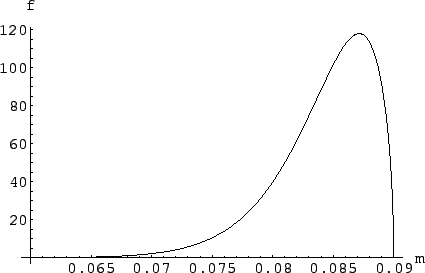 we get
we get
 .
Figure
.
Figure
(********************************************************)
ClearAll["Global`*"]
(* Experiment A has been run at beam energy 0.09, with
sensitivity factor k=20, threshold function beta^3,
and has observed 0 events.*)
ka=20
eba=0.09
v=Sqrt[1-(m/eba)^2]
lambda= ka*v^3
(* f(m) obtained from f(lambda)=Exp[-lambda] by lambda=k beta^3
(threshold factor) using p.d.f transformation *)
fl=Exp[-lambda]
J=Abs[D[lambda, m]]
fm=fl*J
(* check normalization and plot *)
NIntegrate[fm, {m, 0, eba}]
Plot[fm, {m, 0.06, eba}, AxesLabel -> {m, f}]
(* Strange result: try to figure out the reason! *)
(********************************************************)
 |
The result is against our initial rational belief
and we refuse to accept it. The origin of this strange behaviour
is due to the term
 in
(
in
(![]() ) that comes directly from the Jacobian
of the transformation and, indirectly from having assumed
a prior uniform in
) that comes directly from the Jacobian
of the transformation and, indirectly from having assumed
a prior uniform in ![]() . To solve the problem we have
to change prior. But this seems to be cheating.
Should not the prior come before?
How can we change it after we have seen the final distribution?
. To solve the problem we have
to change prior. But this seems to be cheating.
Should not the prior come before?
How can we change it after we have seen the final distribution?
We should not confuse what we think with how we model it.
The intuitive prior is on the mass values, and this prior should be flat
(at least at this stage of the analysis, as discussed in Section
![]() ). Unfortunately, what is flat in
). Unfortunately, what is flat in ![]() is not
flat in
is not
flat in ![]() , and vice versa.
This problem has been discussed in Section
, and vice versa.
This problem has been discussed in Section ![]() .
In fact, it is not really a problem of probability,
but of extrapolating
intuitive probability (which is at the basis of subjective probability and
only deals with discrete numbers)
to continuous variables.
This is the price we pay for using all the mathematical
tools of differential calculus.
But one has to be very careful in formulating the problem. If one wants
to get rid of these problems, one may discretize
.
In fact, it is not really a problem of probability,
but of extrapolating
intuitive probability (which is at the basis of subjective probability and
only deals with discrete numbers)
to continuous variables.
This is the price we pay for using all the mathematical
tools of differential calculus.
But one has to be very careful in formulating the problem. If one wants
to get rid of these problems, one may discretize ![]() and
and ![]() in a way which is consistent with to the experimental resolution.
If we discretize, a flat distribution in
in a way which is consistent with to the experimental resolution.
If we discretize, a flat distribution in ![]() is mapped to
a flat distribution
in
is mapped to
a flat distribution
in ![]() . And the problems caused by the Jacobian go
away with the Jacobian itself, at the expense
of some complications in computation.
. And the problems caused by the Jacobian go
away with the Jacobian itself, at the expense
of some complications in computation.